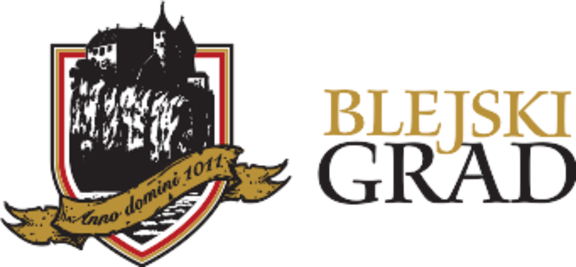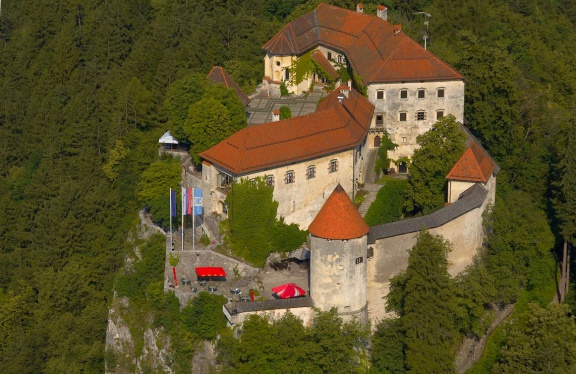Difference between revisions of "Bled Castle"
Ivan Pirnat (talk | contribs) m |
Ivan Pirnat (talk | contribs) (teaser) |
||
| Line 9: | Line 9: | ||
| town = SI-4260 Bled | | town = SI-4260 Bled | ||
| telephone = 386 (0) 4 57 68 455, 386 (0) 4 57 68 454 | | telephone = 386 (0) 4 57 68 455, 386 (0) 4 57 68 454 | ||
| − | | | + | | managed by = National Museum of Slovenia |
| + | |opening hours = May-October: 8am-8pm, November-April: 8am-5pm | ||
| contacts = {{Contact | | contacts = {{Contact | ||
| name = Matjaz Završnik | | name = Matjaz Završnik | ||
| Line 29: | Line 30: | ||
{{Teaser| | {{Teaser| | ||
| − | [[Bled Castle]] | + | |
| + | Bled is one of Slovenia mayor tourist attractions from natural and historic point of view. Especially [[Bled Castle]] standing on the cliff towering over Lake Bled, with high Julijan Alps in the background can be seen in every brochure on Slovenia. It was built in the early 11th century by the Bishops of Freising, and for centuries was the seat of the Bishopric of Gorenjska. In 1511 the castle was badly damaged by an earthquake. The present look of the castle dates from the late 17th century and includes major restoration works carried out in the 1950s. Castle has since late 19th century changed many owners. Preserved from the original building are the Romanesque walls with an entrance tower and the reconstructed wooden defence corridors, while the other sections of the castle are generally in Gothic and Renaissance styles. Today premises of the castle are administered by Bled Culture Institute. There are restaurant, Printing Works, Castle Wine Cellar, Herbal Gallery, Knight's Hall with multi-visions ,Castle Chapel etc., where medieval shows, weddings, concerts, political and corporate events are taking place. Only ''Bled Castle museum exhibition on the history of Bled and its environs'' is set and maintained by [[National Museum of Slovenia]]. Museum in [[Bled Castle]] was established in [[established :: 1957]]. Exhibition was renewed and reopened in year 2008 in 14 chambers of the former residential rooms of the castle. The exhibited original artefacts (a total of some 400) and replicas that are gathered, present Geological, natural, general and art history, archaeology and building phases of the [[Bled Castle]]. Many fossils from different prehistoric periods were discovered in Bled area are on display and also interesting well | ||
| + | |||
| + | |||
| + | [[Bled Castle]] stands on a cliff towering over Lake Bled. The Castle Interior exhibition was prepared by the National Museum in 1957. It features furniture and art objects of a range of styles from Gothic, Renaissance and Baroque to Mannerism, Classicism, Biedermeier and Historicism. Within the castle rooms the history of Bled and Bled Castle is presented, alongside archaeological sites and finds from the environs of Bled. | ||
}} | }} | ||
| + | |||
| + | BLED CASTLE | ||
| + | Museum exhibition on the history of Bled and its environs | ||
| + | |||
| + | Bled with its environs is an exceptional example of how people used, through centuries, their environment in view of the natural and habitational conditions, and in relation to the development of their culture - as currently portrayed by the museum exhibition set up in 14 chambers of the former residential rooms in the castle by the National Museum of Slovenia in collaboration with several other Slovenian museums and private individuals. | ||
| + | The exhibited original artefacts (a total of some 400) and replicas are supplemented by the reconstructed images of the former inhabitants, by the models of Bled Castle and relief model of Bled landscape. The two virtual film presentations speak about the functioning of Bohinj Glacier and the history of Bled Castle construction, while the short documentary films present, with their rich pictorial material and original sequences, the archaeological heritage of the ancient Castle, the outset of spa tourism at Bled, the Bohinj railway, and various cultural and sports manifestations at Bled. | ||
| + | The origin of today's landscape, as shaped by the glacier, is part of presentation of the geological and natural environment and of the gradual development of cultural landscape that integrates the heritage of various periods. The archaeological finds speak, together with documented remains of settlements, graveyards, sanctuaries, hillforts and roads, about the way of habitation by individuals and communities, about the people's attitude towards nature, and how they were torn between earth and sky. | ||
| + | Here, numerous traces were left by the Ice Age hunters, the first Stone Age tillers and stockbreeders, the Copper, Bronze and Iron Age settlers by whom metals were already used, as well as by indigenous inhabitants from the Roman Period and Late Antiquity. The Bled Corner (Blejski kot) is also one of the archaeologically best researched areas in Slovenia for the Early Mediaeval and Early Slavic Period, when villages and roads, as still recognized in the cultural landscape today, were built. | ||
| + | At the exhibition, the data and depictions from historical sources (kept in the archives in Slovenia and abroad) delineate, together with the exhibited artefacts, the Bled feudal dominion owned by the Brixen Diocese from Tyrol through the period of eight centuries (1004-1803). The development of Bled into a health and tourist resort in the 19th and 20th centuries is presented with exhibits, films and depictions of notable people and events. | ||
| + | The millennium old Bled Castle, however, is not merely an exhibition ground from which the renowned islet with its pilgrim church in the middle of the lake can be admired, but a component part of the exhibition, too. As a monument and scenic viewpoint in space and time, preserved and interacting with each other at Blejski kot, it presents, together with the exhibition, the heritage, valuable feature, stimulation and challenge not only to the locals but all Bled visitors as well. | ||
| + | |||
| + | LINKS | ||
| + | Zavod za kulturo Bled www.zavod-za-kulturo-bled.si. | ||
Various cultural programmes are programmed here by [[Bled Cultural Institute]]. | Various cultural programmes are programmed here by [[Bled Cultural Institute]]. | ||
Revision as of 23:44, 18 January 2010
BLED CASTLE Museum exhibition on the history of Bled and its environs
Bled with its environs is an exceptional example of how people used, through centuries, their environment in view of the natural and habitational conditions, and in relation to the development of their culture - as currently portrayed by the museum exhibition set up in 14 chambers of the former residential rooms in the castle by the National Museum of Slovenia in collaboration with several other Slovenian museums and private individuals. The exhibited original artefacts (a total of some 400) and replicas are supplemented by the reconstructed images of the former inhabitants, by the models of Bled Castle and relief model of Bled landscape. The two virtual film presentations speak about the functioning of Bohinj Glacier and the history of Bled Castle construction, while the short documentary films present, with their rich pictorial material and original sequences, the archaeological heritage of the ancient Castle, the outset of spa tourism at Bled, the Bohinj railway, and various cultural and sports manifestations at Bled. The origin of today's landscape, as shaped by the glacier, is part of presentation of the geological and natural environment and of the gradual development of cultural landscape that integrates the heritage of various periods. The archaeological finds speak, together with documented remains of settlements, graveyards, sanctuaries, hillforts and roads, about the way of habitation by individuals and communities, about the people's attitude towards nature, and how they were torn between earth and sky. Here, numerous traces were left by the Ice Age hunters, the first Stone Age tillers and stockbreeders, the Copper, Bronze and Iron Age settlers by whom metals were already used, as well as by indigenous inhabitants from the Roman Period and Late Antiquity. The Bled Corner (Blejski kot) is also one of the archaeologically best researched areas in Slovenia for the Early Mediaeval and Early Slavic Period, when villages and roads, as still recognized in the cultural landscape today, were built. At the exhibition, the data and depictions from historical sources (kept in the archives in Slovenia and abroad) delineate, together with the exhibited artefacts, the Bled feudal dominion owned by the Brixen Diocese from Tyrol through the period of eight centuries (1004-1803). The development of Bled into a health and tourist resort in the 19th and 20th centuries is presented with exhibits, films and depictions of notable people and events. The millennium old Bled Castle, however, is not merely an exhibition ground from which the renowned islet with its pilgrim church in the middle of the lake can be admired, but a component part of the exhibition, too. As a monument and scenic viewpoint in space and time, preserved and interacting with each other at Blejski kot, it presents, together with the exhibition, the heritage, valuable feature, stimulation and challenge not only to the locals but all Bled visitors as well.
LINKS Zavod za kulturo Bled www.zavod-za-kulturo-bled.si. Various cultural programmes are programmed here by Bled Cultural Institute.
See also
- National Museum of Slovenia
- Snežnik Castle Museum
- Hrušica - Museum Collection and Archaeological Park
- National Museum of Slovenia - Metelkova




